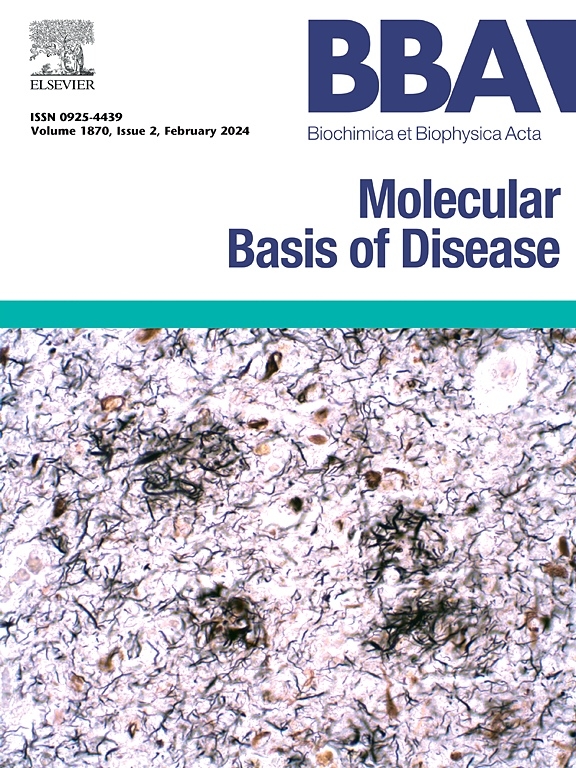Novel LBR pathogenic variants with loss of sterol reductase activity participate in the pathogenesis of skeletal dysplasia via dysregulating canonical Wnt pathway
IF 4.2
2区 生物学
Q2 BIOCHEMISTRY & MOLECULAR BIOLOGY
Biochimica et biophysica acta. Molecular basis of disease
Pub Date : 2025-05-10
DOI:10.1016/j.bbadis.2025.167901
引用次数: 0
Abstract
Biallelic pathogenic variants in the lamin B receptor (LBR) with impaired sterol reductase function are associated with the development of perinatal lethal Greenberg dysplasia (GRBGD) and mild nonfatal skeletal dysplasia with or without Pelger-Huet anomaly (PHASK), as well as other related hereditary skeletal dysplasia. However, the underlying molecular mechanism remains unclear. In this study, we found two novel pathogenic variants of LBR, namely missense mutation (c.1011 T > G, NM_002296.4; p.Cys337Trp, NP_002287.2) and LBR gene deletion (Chr1q42.12 (225,515,082-225,633,464), NC_000001.10). LBR is a novel substrate of FBW7, which is degraded by GSK3β/FBW7-mediated proteasome pathway and whose C337W mutation promotes its degradation through enhanced interaction with FBW7. Wild-type but not C337W mutant LBR is upregulated by WNT3A-mediated inactivation of GSK3β/FBW7 axis and then participated in WNT3A-activated Wnt pathway through its mediated cholesterol synthesis. MC3T3-E1 cells with Lbr knockdown or cholesterol removal exhibited reduced mineralized nodules in the presence of WNT3A, but addition of cholesterol in the culture medium reversed this phenotype. Collectively, we detected two novel variants in LBR and our study revealed for the first time that disruption of cholesterol synthesis by LBR impairs Wnt pathway and thus disrupts the cell osteogenic differentiation, providing new insights into the pathogenesis of skeletal dysplasia caused by LBR variation.
具有甾醇还原酶活性丧失的新型LBR致病变异通过失调的典型Wnt通路参与骨骼发育不良的发病机制。
具有受损的甾醇还原酶功能的纤层蛋白B受体(LBR)的双等位基因致病性变异与围产期致死性格林伯格发育不良(GRBGD)和轻度非致死性骨骼发育不良(伴或不伴Pelger-Huet异常(PHASK))以及其他相关的遗传性骨骼发育不良的发生有关。然而,潜在的分子机制尚不清楚。在本研究中,我们发现了两种新的LBR致病变异,即错义突变(c.1011 T > G, NM_002296.4;p.Cys337Trp, NP_002287.2)和LBR基因缺失(Chr1q42.12 (225,515,082-225,633,464), NC_000001.10)。LBR是FBW7的新型底物,通过GSK3β/FBW7介导的蛋白酶体途径降解,其C337W突变通过增强与FBW7的相互作用促进其降解。野生型而非C337W突变体LBR通过wnt3a介导的GSK3β/FBW7轴失活而上调,然后通过其介导的胆固醇合成参与wnt3a激活的Wnt通路。在WNT3A存在的情况下,Lbr敲除或胆固醇去除的MC3T3-E1细胞显示矿化结节减少,但在培养基中添加胆固醇逆转了这种表型。总之,我们在LBR中发现了两个新的变异,我们的研究首次揭示了LBR对胆固醇合成的破坏会损害Wnt通路,从而破坏细胞成骨分化,为LBR变异引起的骨骼发育不良的发病机制提供了新的见解。
本文章由计算机程序翻译,如有差异,请以英文原文为准。
求助全文
约1分钟内获得全文
求助全文
来源期刊
CiteScore
12.30
自引率
0.00%
发文量
218
审稿时长
32 days
期刊介绍:
BBA Molecular Basis of Disease addresses the biochemistry and molecular genetics of disease processes and models of human disease. This journal covers aspects of aging, cancer, metabolic-, neurological-, and immunological-based disease. Manuscripts focused on using animal models to elucidate biochemical and mechanistic insight in each of these conditions, are particularly encouraged. Manuscripts should emphasize the underlying mechanisms of disease pathways and provide novel contributions to the understanding and/or treatment of these disorders. Highly descriptive and method development submissions may be declined without full review. The submission of uninvited reviews to BBA - Molecular Basis of Disease is strongly discouraged, and any such uninvited review should be accompanied by a coverletter outlining the compelling reasons why the review should be considered.

 求助内容:
求助内容: 应助结果提醒方式:
应助结果提醒方式:


